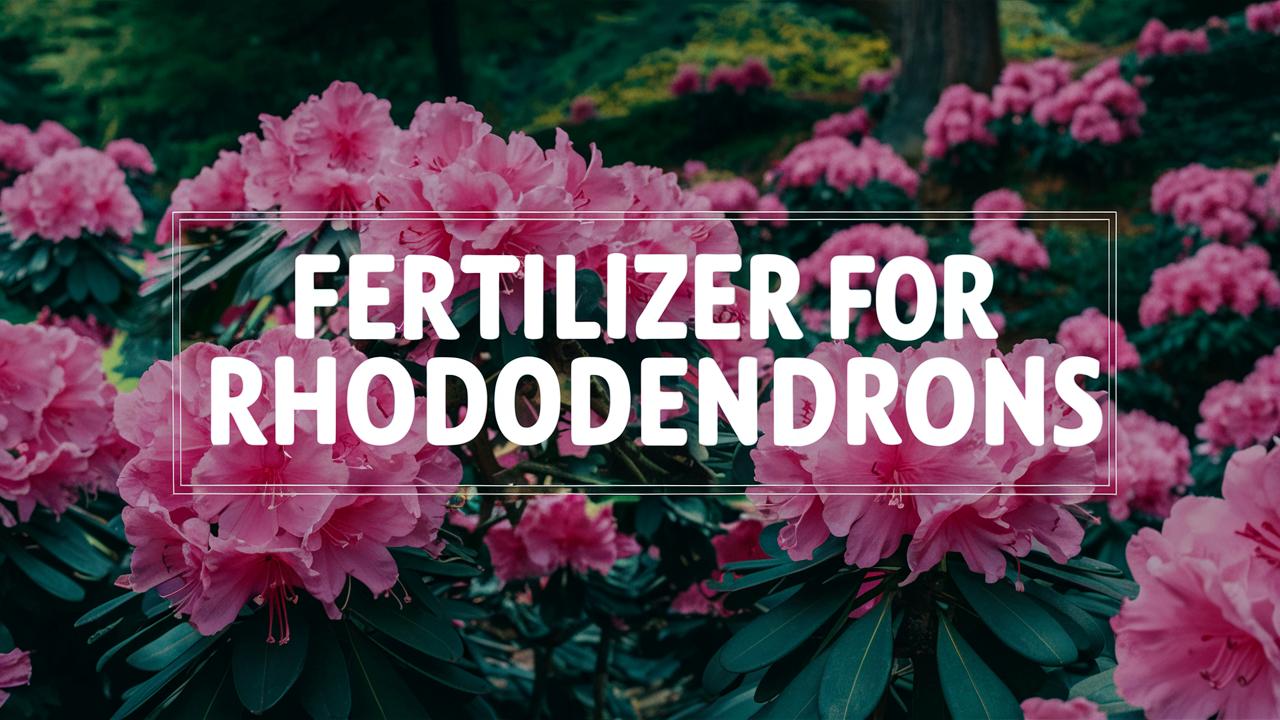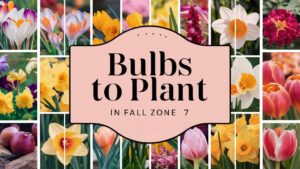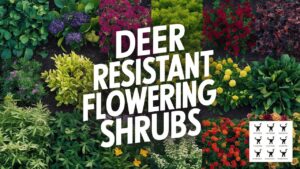In this guide, we’ll explore the essential aspects of choosing fertilizers for rhododendrons—digging into their unique nutritional needs, understanding soil requirements, deciphering fertilizer labels, and offering tips on application. Let’s get started on this journey toward thriving rhododendrons!
Fertilizer For Rhododendrons
| Image | Name | Rating | Shop |
|---|---|---|---|
 | Fertilome Azalea, Camellia, Rhododendron Food |  | |
 | Azalea and Camellia Food |  | |
 | Slow-Release ACR Fertilizer |  |
Fertilome Azalea, Camellia, Rhododendron Food
Fertilome Azalea, Camellia, Rhododendron Food 9-15-13 is a high-quality fertilizer specifically designed to meet the needs of acid-loving plants like rhododendrons. This product provides essential nutrients such as nitrogen, phosphorus, and soluble potash in a balanced 9-15-13 formula.
If you’re looking for a fertilizer that can help your rhododendron thrive and grow, this is a great option. With easy-to-follow application instructions, it’s simple to provide your plants with the nutrients they need to flourish. Follow the recommended feeding schedule of early spring, after blooming, and fall, and use the specified amounts based on the size of your plant. For best results, feed your rhododendron 1/4 to 1/2 cup for small plants (1-5 ft), or 3/4 to 1 1/4 cups for larger ones (6-12 ft).
Azalea and Camellia Food
When it comes to fertilizing rhododendrons, you want a product that’s specifically designed for low-pH plants like azaleas, camellias, and rhododendrons too. True Organic Azalea, Camellia & Rhododendron Food is an excellent choice, formulated with organic and nutrient-rich ingredients such as seabird guano, shrimp and crab shell meal.
It’s worth noting that this product encourages lush blooming on acid-loving plants by promoting healthy growth through twice-yearly applications in spring and fall. If you’re looking to apply fertilizer to a larger area or more plants, True Organic Azalea, Camellia & Rhododendron Food comes in 4lb (covers up to 87 sq. ft.) or 12lb bags that can cover more than double the space. Both should suit various garden sizes.
Slow-Release ACR Fertilizer
This slow-release fertilizer from Schultz is suitable for rhododendrons, providing nutrients over a longer period to promote healthy growth and blooming.
The 36% available nitrogen ensures that plants receive essential nutrients while also reducing the need for frequent fertilization. It’s beneficial for acid-loving plants like rhododendrons because it doesn’t contain any phosphorus or potassium that would alter the pH balance of soil.
Gardenwise 8-4-8 Fertilizer.
The 8-4-8 Acidic Fertilizer from Gardenwise is a great choice for rhododendrons. It’s specifically designed for acid-loving plants like azaleas, camellias, hydrangeas, blueberries, gardenias, magnolia trees, evergreens, and of course, rhododendrons. This fertilizer provides essential nutrients like magnesium, iron, and manganese that are crucial for preventing chlorosis in these types of plants.
We recommend Gardenwise 8-4-8 because it’s easy to use – simply sprinkle the granules around the base of your plants, mix into the soil, and water. It’s also a cost-effective option that only requires three feedings per year, making it an economical choice for gardeners who want to provide long-lasting nutrition to their rhododendrons without breaking the bank.
Dr. Earth Fertilizer
If you’re looking for a fertilizer that’s specifically designed to meet the needs of your rhododendrons, we would recommend Dr. Earth Organic & Natural MINI Acid Lover Azalea, Camellia, Rhododendron & Maple Fertilizer (1 lbs). This product is formulated with a blend of organic and natural ingredients that are tailored to promote healthy growth and vibrant flowers on acid-loving plants like rhododendrons.
The benefits of using Dr. Earth Organic & Natural MINI Acid Lover Fertilizer include its non-GMO project verified status, making it safe for both people and pets. It’s also handcrafted from high-quality ingredients that are free from synthetic chemicals and toxic substances. With a focus on promoting healthy soils and supporting sustainable gardening practices, this product is a great choice for environmentally-conscious gardeners who want to get the most out of their rhododendrons without compromising their values.
Rhodox fertilizer
Rhododendron plants require specific care when it comes to fertilization to ensure they receive essential nutrients for healthy growth. Considering their unique nutritional needs, TPS NUTRIENTS’ Rhododendron Fertilizer stands out as a product that caters to the requirements of these sensitive plants.
This concentrated liquid fertilizer is specifically formulated for all types of Rhodic acid plant families, such as Azaleas and Ericaceae. It provides balanced nourishment to promote dense foliage and vibrant blooms on your Rhododendron plants. Given its targeted approach toward specific plant types, TPS NUTRIENTS’ Rhododendron Fertilizer should be given due consideration when looking for the right product to meet their needs.
Schultz Azalea, Camellia, Rhododendron
Rhododendrons can be finicky when it comes to fertilizing, but with Schultz Azalea, Camellia, Rhododendron, ACR 14-7-7 Slow Release Plant Food, you’ll get the nutrients your plants need without the hassle. This slow release plant food is designed specifically for azaleas, camellias, and rhododendrons, providing a balanced formula of nitrogen, phosphorus, and potassium (14-7-7) that promotes healthy growth and blooming.
What sets this product apart from other fertilizers is its slow release technology. This means you won’t have to worry about over-fertilizing or under-fertilizing your plants – a 3.5 lb bag will provide a steady supply of nutrients for months, eliminating the need for frequent applications. Plus, it’s easy to use: simply sprinkle around the base of your plants and water in, no mixing required. The addition of micronutrients ensures that your rhododendrons receive all the necessary nutrients for optimal health.
How to Choose a Fertilizer for Rhododendrons
Rhododendrons are among the most breathtaking flowering shrubs, celebrated for their stunning clusters of colorful blooms. These hardy, evergreen plants lend an air of elegance to any garden, but their spectacular display is largely dependent on proper care, particularly when it comes to choosing the right fertilizer. If you’re wondering how to nurture these beautiful plants with the right nutrients, you’ve come to the right place.
Understanding the Nutritional Needs of Rhododendrons
To effectively choose a fertilizer for your rhododendrons, it is vital first to grasp their nutritional requirements. These plants thrive in slightly acidic soil, typically preferring pH levels between 4.5 and 6.0. Unlike many plants, rhododendrons are sensitive to the availability of certain nutrients, which means their fertilization regimen must be tailored to promote healthy growth and vibrant blooms.
Key Nutrients
Nitrogen (N): Crucial for foliage development, nitrogen ensures that your rhododendrons grow lush and green. It supports cellular growth and overall vigor.
Phosphorus (P): Important for root and flower development, phosphorus encourages strong root systems and stimulates blooming. This nutrient is essential during the early growing season.
Potassium (K): Potassium helps improve the plant’s overall health by enhancing disease resistance, regulating water use, and facilitating photosynthesis. It is particularly vital during blooming periods.
Micronutrients: In addition to the three main elements (N-P-K), rhododendrons require micronutrients such as iron, manganese, and zinc for optimal growth. These nutrients are crucial for a range of physiological processes within the plant. A deficiency can lead to chlorosis, delayed flowering, and poor growth.
When selecting a fertilizer, consider these key nutrients and their ratios to ensure you’re giving your rhododendrons a well-rounded diet.
Soil Considerations
Before reaching for that bag of fertilizer, take a moment to assess your soil. Healthy, well-aerated soil is critical for your rhododendrons’ success. Here are a few pointers on what to consider regarding soil health:
Soil pH
As mentioned earlier, rhododendrons thrive in acidic soil. Conduct a soil test to determine the pH level of your gardening area. If your soil leans towards alkaline, you may want to consider ways to amend it, perhaps with elemental sulfur or organic matter to lower the pH.
Soil Composition
Rhododendrons prefer well-drained, loamy soil rich in organic matter. Evaluate the texture and structure of your soil. Incorporating organic amendments such as compost or well-rotted leaf mold can improve soil health, enhance nutrient retention, and create an ideal growing environment.
Drainage Capabilities
Good drainage is crucial for preventing root rot in rhododendrons. Ensure that your selected fertilization method does not cause water retention at the roots. Raised beds or incorporating organic matter into your planting area can improve drainage significantly.
Types of Fertilizers for Rhododendrons
Once you’ve evaluated the nutritional needs of your rhododendrons and assessed your soil conditions, you can explore the types of fertilizers available. There are several options, each with distinct characteristics:
Organic Fertilizers
Organic fertilizers, derived from natural sources, are an excellent choice for rhododendrons. These fertilizers release nutrients slowly, minimizing the risk of nutrient burn and promoting sustainable plant health. Common organic fertilizers include:
Compost: Rich in nutrients and beneficial microorganisms, compost improves soil structure and health while providing an excellent slow-release source of nutrients.
Fish Emulsion: This organic fertilizer is rich in nitrogen and trace minerals, offering a well-balanced nutrient profile.
Bone Meal: High in phosphorus, bone meal encourages blooming and root development, making it an excellent addition during the planting phase.
Kelp Meal: Packed with micronutrients and growth hormones, kelp meal adds valuable nutrients and drives healthy growth.
Synthetic Fertilizers
Synthetic fertilizers offer immediate nutrient availability, making them a fast-acting option for rhododendrons. However, caution should be exercised, as over-fertilization can lead to excessive growth at the expense of blooms. Synthetic options typically come in granular or liquid form. When choosing synthetic fertilizers:
Granular Fertilizers: Often mixed into the soil before planting, these fertilizers provide a steady nutrient release.
Liquid Fertilizers: These are usually diluted in water and can be applied directly to the soil or foliage. They are beneficial for addressing immediate nutrient deficiencies.
Fertilizers for rhododendrons commonly have an N-P-K ratio such as 10-8-6 or similar variations. Make sure to choose a product specifically designed for acid-loving plants or those labeled for use with shrubs and perennials. Reading the packaging carefully and selecting a fertilizer that meets your plants’ nutritional needs is crucial.
Understanding Fertilizer Labels
Navigating fertilizer labels can initially feel overwhelming, but focusing on specific details can simplify the process significantly. Here’s what to look for:
N-P-K Ratio
The numbers displayed on a fertilizer package represent the N-P-K ratio, indicating the percentage of nitrogen, phosphorus, and potassium. For instance, in a 10-8-6 fertilizer, there are 10% nitrogen, 8% phosphorus, and 6% potassium. Consider the specific needs of your rhododendrons. For example, if promoting flowering is your primary goal, choose a higher phosphorus ratio.
Micronutrient Content
Ensure that the fertilizer contains the essential micronutrients necessary for rhododendron health. Look for traces of iron or magnesium listed in the ingredients—these support chlorophyll production and overall vitality.
Release Method
Some fertilizers are quick-release, providing an instant nutrient boost, while others are slow-release, offering benefits over an extended period. For rhododendrons, slow-release options are often preferred as they supply a consistent nutrient base without the risk of over-fertilizing.
Timing Your Fertilization
Another critical aspect when selecting a fertilizer for your rhododendrons is timing. Proper scheduling can significantly impact the effectiveness of your fertilization regimen.
Early Spring Application
The optimal time to fertilize rhododendrons is in early spring, just before new growth emerges. This timing fosters robust foliage development and encourages abundant blooms as the growing season commences.
Mid-Summer Top-Dressing
If you’re using slow-release organic fertilizers, a mid-summer top-dressing can provide a nutrient boost during the blooming season. This allows rhododendrons to replenish their nutrient reserves and continue showcasing vibrant blooms throughout the summer months.
Fall Considerations
Avoid fertilizing in late summer or fall as this can encourage new growth that may not fully harden off before colder temperatures arrive. Late-season fertilization can make plants more susceptible to winter damage.
Application Techniques for Fertilizers
Once you’ve chosen the right fertilizer and established a schedule, it’s essential to apply it correctly to maximize its effectiveness. Here’s how:
Granular Fertilizers
Pre-Planting: If you’re planting new rhododendrons, mix the granular fertilizer into the planting hole at the recommended rate.
Established Plants: For existing rhododendrons, apply granular fertilizers evenly around the plant’s drip line, avoiding direct contact with the roots.
Water Thoroughly: After applying, water the area well to help the fertilizer penetrate the soil.
Liquid Fertilizers
Dilution: Follow the manufacturer’s instructions to dilute the liquid fertilizer in water properly. Be cautious not to exceed recommended strengths.
Application: Use a watering can or hose attachment to even out the application. Focus on the base of the plant and avoid spraying concentrated solutions directly on the leaves, as this may lead to leaf burn.
Frequency: Liquid fertilizers may need more frequent applications, particularly during the active growing season. Monitor your plant’s response to adjust your schedule accordingly.
Common Mistakes to Avoid
Even seasoned gardeners can make missteps in fertilizing rhododendrons. Here are some common pitfalls to steer clear of:
Over-Fertilization
Applying too much fertilizer can harm your rhododendrons, leading to excessive foliage growth at the expense of blooms and causing root burn. Stick to recommended rates and observe your plants closely for signs of stress.
Ignoring Soil Health
Feeding plants without considering their soil condition can create imbalances. Always assess soil quality and work on improving its structure through organic matter before adding fertilizers.
Fertilizing New Plants Too Soon
If you’ve just planted your rhododendron, resist the urge to fertilize immediately. Give the plant time to establish its roots in the new soil environment.
Signs of Nutrient Deficiency
Understanding how to recognize nutrient deficiencies is crucial for optimizing your rhododendrons’ health. Here are some common signs to watch for:
Yellowing Leaves: Particularly in younger leaves, this could be indicative of nitrogen deficiency.
Stunted Growth: If your rhododendrons show poor growth or lack vigor, it may signal a need for additional nutrients.
Poor Flowering: Reduced or absent blooms can indicate insufficient phosphorus or potassium levels.
Regularly monitoring your plants and addressing these signs promptly can help maintain their health and vitality.
Conclusion
Choosing the right fertilizer for rhododendrons might seem daunting, but by understanding their unique nutritional needs, assessing your soil conditions, and making informed choices regarding fertilizer types and application methods, you can promote healthy growth and dazzling blooms.









